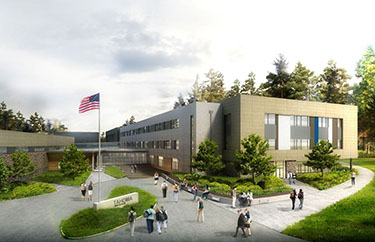|
Subscribe / Renew |
|
|
Contact Us |
|
| ► Subscribe to our Free Weekly Newsletter | |
| home | Welcome, sign in or click here to subscribe. | login |
Construction
| |
 |
August 20, 2015
High-tech tools help contractors keep up as school construction booms
Skanska USA Building

King
|
AK-12 school construction boom is underway, thanks to population growth and aging school infrastructure. In fact, it’s one the biggest construction sectors in Washington this year.
According to the state Office of Financial Management, the population in Washington grew by 1.34 percent in the last year, passing the 7 million-resident mark.
This population boom has school districts on their toes addressing overcrowded schools and outdated facilities. For example, Tacoma Public Schools has 18 schools under construction this summer.
Typical school construction projects are small in scope and usually address immediate needs. As school infrastructure is aging and no longer suiting the needs of the growing population, we are now seeing large school expansion projects, including renovations and new school construction.
Tahoma High
Skanska USA Building is currently working on seven Western Washington K-12 construction projects. Utilizing virtual design and construction (VDC) as a tool to improve construction delivery methods, Skanska is reducing the risk of job-related injuries on their K-12 projects during this construction boom.
For example, the Tahoma School District is addressing growth demands by building a new Tahoma High School in Maple Valley to eliminate significant overcrowding. Skanska is strategically implementing VDC processes for the project and seeing impressive results:
• VDC was used for Tahoma High in preconstruction to extract “quantities” from the models (referring to detailed measurements of materials and labor) and to compare them between design releases. Skanska worked with the design team to automate quantity “takeoff” from the design models (for bids and pricing), and developed Revit building-information modeling software templates that allowed models to be linked and instantly provide feedback on quantities.
• 3-D modeling software is used to develop layout drawings which aggregate all the information required for Skanska crews to build the new high school structure. The model is then divided into several phased “lift” drawings.
This saves trade personnel significant time in locating the information from multiple locations of the drawings set. This software is especially helpful at visualizing constructability issues, addressing design challenges and updating construction drawings.
Completed lift drawings are made available to all project personnel via “Digital Resource Stations” on the project or with tablet PCs, allowing the trades to access the information on the job site rather than having to go to the project office each time a question arises.
• Point layout software allows the VDC team or layout staff to insert geo-referenced points into the 3-D model.
The coordinates of those points can then be extracted to an Excel file and loaded into layout equipment used to stake out building components such as structure, parking and sports fields.
Point Layout software has streamlined the otherwise time-consuming and human-error-ridden manual layout process and saves hundreds of hours and thousands of dollars per project, benefiting both the contractor and the school district.
• Skanska leverages a cloud-based collaboration system to work seamlessly with our mechanical, electrical and plumbing (MEP) subcontractors to ensure that the schools’ systems are fully coordinated prior to the start of installation. 3-D MEP coordination allows us to identify and resolve constructability issues in the office instead of the in the field. This results in eliminating rework, avoiding schedule deviations and improving subcontractor efficiency.
• Skanska developed a 3-D site safety and logistics model that includes useful information like location of drive lanes, site entry points, first aid stations, hazardous material spill kits, and evacuation routes for the job site. This standardized safety model is easy for the team to create and update as the project progresses through various phases. Often things like first aid stations will be moved around the site to accommodate site conditions.
The model provides a clear and accurate safety plan for trade orientation and for crews to review at their daily safety briefings. Safe delivery of the project is a primary focus area for both the school district and the contractor.
Other projects
Several other VDC processes are in use on other Skanska K-12 projects.
For renovations, laser-scanning technology captures existing structures after the interiors are demolished to produce a real world, as-built model. Due to the age of the building and lack of design technologies when the schools were built, there are often differences between the as-built drawings and the actual structure. The laser scans are then modeled in Revit and provided to the design team as the basis for their design.
Helicopter drones outfitted with pivoting cameras are leveraged for both aerial photography and mapping project sites or corridors. The cost of using manned aircraft for aerial photography can be prohibitive for smaller projects. The cost of a drone and the associated training can quickly be recovered by eliminating the cost for manned aircraft, and allows the team to photograph the site more often during the project.
Advances in VDC technology over the past several years have given contractors the tools to drive value by streamlining construction processes and eliminating waste. This also benefits clients by creating efficiencies and time savings so school projects, and others, can be delivered on time and on budget.
During this construction boom efficiency and effective communication will define the success of a project. Skanska’s project teams are working closely with the VDC staff to develop innovative processes that streamline construction and clearly delineate the requirements and coordination of a project. The processes defined above are only a small part of the VDC activities that Skanska leverages in both preconstruction and construction.
Mark King, a virtual design and construction manager for Skanska USA Building, has been working in design and construction for more than 30 years in the Seattle area and the Middle East.
Other Stories:
- Landmark Paul Thiry school reopens to students after 34 years
- New Vancouver high school prepares students for careers in health care
- Students have their say in Seattle school project
- The grass is actually greener for schools that install synthetic turf
- A ‘third place’: where students can be themselves
- Six trends shaping the future of campus design
- Bellevue College will open its first on-campus housing in 2018
- How to make existing schools healthier, more efficient
- You can have a safe school theater — even on a budget
- How to design schools to prepare kids for careers that don’t exist yet



